Abstract
Intention, Goal, Scope, Background
BASF has developed the tool of eco-efficiency analysis to address not only strategic issues, but also issues posed by the marketplace, politics and research. It was a goal to develop a tool for decision-making processes which is useful for a lot of applications in chemistry and other industries. Objectives. The objectives were the development of a common tool, which is usable in a simple way by LCA-experts and understandable by a lot of people without any experience in this field. The results should be shown in such a way that complex studies are understandable in one view.
Methods
The method belongs to the rules of ISO 14040 ff. Beyond these life cycle aspect costs, calculations are added and summarized together with the ecological results to establish an eco-efficiency portfolio.
Results and Discussion
The results of the studies are shown in a simple way, the eco-efficiency portfolio. Therefore, ecological data are summarized in a special way as described in this paper. It could be shown that the weighting factors, which are used in our method, have a negligible impact on the results. In most cases, the input data have an important impact on the results of the study. Conclusions. It could be shown that the newly developed eco-efficiency analysis is a new tool, which is usable for a lot of problems in decision-making processes. It is a tool which compares different alternatives of a defined customer benefit over the whole life cycle.
Recommendations and Outlook
This new method can be a helpful tool in different fields of the evaluation of product or process alternatives. It can be used in research and development as well as in the optimization of customer processes and products. It is an analytical tool for getting more sustainable processes and products in the future
Similar content being viewed by others
Explore related subjects
Discover the latest articles, news and stories from top researchers in related subjects.References
Fussier C (1999): Die öko Innovation. S. Hirzel Verlag Stuttgart, Leipzig, 127
WBCSD Congresses in Antwerp, November (1993), March (1995) and Washington, November (1995); WBCSD: Eco-efficient leadership for improved economic and environmental performance (1996)
von Weizsäcker EU, Seiler-Hausmann J (Ed) (1999): ökoeffizienz Management der Zukunft. Birkhäuser Verlag, Switzerland, ISBN 3-7643-6069–0
Hungerbühler K, Ranke J, Mettier T (1999): Chemische Produkte und Prozesse. Springer Verlag Berlin, ISBN 3-540-64854–2
Ciba Spezialitätenchemie, Umwelt, Gesundheit und Sicherheit—Innovationen im Umweltbereich
Schrott W, Saling P (2000): Melliand Textilberichte 3, 190–194
Once BASF, since October, 1st , 2000 BASF Indigo is marketed by DyStar
Once BASF, since October, 1st , 2000 BASF Indigo is marketed by DyStar
Once BASF, since October, 1st , 2000 BASF Indigo is marketed by DyStar
Union for the Coordination of Transmission of Electricity
UBA, C.A.U., ifeu, Methodik der produktbezogenen ökobilanzen, Wirkungsbilanz und Bewertung, Texte 23/95
Schriftenreihe Umwelt Nr. 132 (1991): Bundesamt für Umwelt, Wald und Landschaft (BUWAL), Bern
Regulation on requirements for the discharge of wastewater into surface waters (Abwasserverordnung—AbwV) of March 27(1997)
US Geological Survey, Mineral Commodity Summaries (1997)
Römpp Chemie Lexikon, Thieme, Stuttgart; Institute for World Economy, Kiel (1998); Hargreaves D, Eden-Green M, Devaney J (1993): World Index of Resources and population, Dartmouth publishing. World resources, Guide to the Global Environment, Oxford (1996). German Institute for Economic Research, Berlin (1998)
LD50 = lethal dose killing 50% of experimental animals
Data i.e. of BG Chemie or other BGs, VDA 2000, etc.
The data may come from the statistical yearbook for Germany, for example
DIN 33927 covers the use of life cycle assessments in marketing, promotion and public relations
Author information
Authors and Affiliations
Corresponding author
Rights and permissions
About this article
Cite this article
Saling, P., Kicherer, A., Dittrich-Krämer, B. et al. Eco-efficiency analysis by basf: the method. Int J LCA 7, 203–218 (2002). https://doi.org/10.1007/BF02978875
Received:
Issue Date:
DOI: https://doi.org/10.1007/BF02978875




